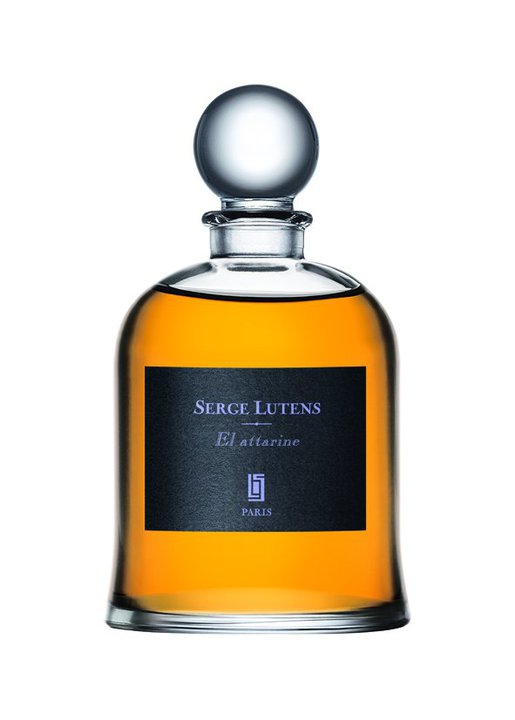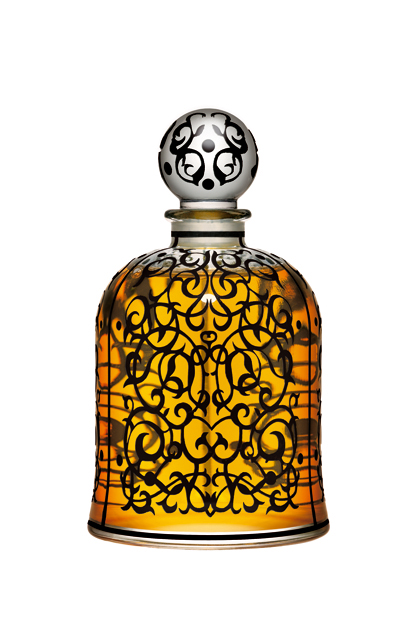Serge Lutens El Attarine (2008): If You Could Take With You One Earthly Smell to Paradise, What Would it Be? {Perfume Review & Musings}

When I poke my nose into El Attarine (The Sweet-Smelling One), a little whirlwind of sensations engulfs me. I think of Arabie, one of my two first purchases of Serge Lutens parfums, with Douce Amère, when the house was newly founded; I think of baskets in a bazaar filled with honeyed dry fruits and other darkly shiny edibles. There are the recurrent woods of Féminité du Bois, which Lutens has likened to a cedar pastry; if you know the smell of Virginian cedar wood, this is what I think of too: a gourmand cedarwood. The fragrance pulls you inside the gustatory palette of the perfumer as you recognize a great deal of the familiar Lutensian notes developed over the years - their consistency too...
Having appeared in 2008, inspired in part by the mosque of Fès in Morocco, and now turning my attention to it in 2013, I have to approach it, not like a new chapter in the olfactory autobiography of Serge Lutens thinking it is the latest state of his mind, but as one fragrance sandwiched in-between the years.
What I can think of right now is how immensely gourmand the work of Lutens is, collaborating with nose Christopher Sheldrake.
What I smell in El Attarine is carvi. It's distinct from the sweatier and more human-shaped cumin although closely related. It smells of carvi or caraway in a distinctive manner. And of course, what with the orange-colored jus in the bottle - and the beginning of a salivating reaction in my mouth - I have to say something incongruous but true in this very instant: the perfume smells of Holland cheese, of Gouda spiced up with carvi, eaten however with a serving of apricot jam on the side in the Scandinavian manner - and the American manner too - mixing savory cheese with jam. Carvi is also called "cumin from Holland" because despite the fact that it's "carum carvi" we find in cheeses there, it's still called "cumin" - but it's not cumin, it's carvi.
Interestingly, food historians note that carvi is the spice consumed in the North while cumin is the spice which is popular in the South - India in particular. Both Lutens and Sheldrake come from the North, having been brought up on Northen European foodways, with a detour in India for Sheldrake, as I already pointed out in my review of Fourreau Noir. And while Santal Mysore is about cumin, El Attarine is more cross-cultural.
Going back in time on the blog, I find this useful quote by Lutens at the time of the launch of El Attarine:
"There is no distinction between the olfactory and the gustatory, until the
moment when you decide whether to taste or smell."
The French are not very religious. In fact, I remember a study stating that they are the least religious people in the world. At the other end of the spectrum, we have the Americans, who in the same study were said to be the most religious people in the world. Religious feasts however are duly celebrated in France. Because it is a good opportunity to revere what truly deserves to be revered according to this country: food.

For a perfume inspired by a Muslim place of worship, the fragrance is strangely foody and gustatory rather than elevated. It's like a French twist on Islam. It's more Ramadan-caraway-pudding, than mystical offering. Everybody eats, and Ramadan is filled with banquets but you would have expected a little curtsey to the gods that would be more pronouced. I try to detect, say, incense. There is a slightly smoky nuance, but it's not very pronounced, a by-product it seems of amber with its pyrazine aspect.
Where the perfume takes flight and becomes song on the skin is as a skin perfume with apricoty nuances. The perfume rounds off, the apricot melding into the skin and making you smell like a more sublime version of yourself. The effect is discreet but is undeniable. It reminds you of a perfume that came after it, Bottega Veneta, with its leather and apricot mimicking the scent of skin. I wished I had an apricot handy because I am sure now that the fruit must have natural affinities with the smell of human skin. The vanilla helps too. A Vanille Abricot by Comptoir Sud Pacifique, only more subtle and spiced up?
On the current Serge Lutens website, we have the house desciption:
"More Arabian than ever!" [...] "There are woods but to them I add the more intimate scent of skin. You can guess its presence underneath the tangle of saffrons and musks -- it's cumin!"
The drydown of the perfume is probably its best part as it is wont to be for a skin perfume but also what I perceive to be a soft Oriental. It's a perfume in minor mode. Its effects are all very toned down.
Eau d'Hermès is famous for its overdose of cumin which makes it smell like a ravaged bed. Here, the scent of skin is much more saintly, and this is where perhaps we reconnect with a more spiritual dimension as its name promises. It's the feable, subtle perfume emanating from the skin of a saint whose diet is mostly prayers, water, bread and the scent of apricoty roses. For a gourmand perfume, El Attarine is indeed curiously desincarnated; for a spicy Oriental as well. This is where in the end you would be able to stop and pause to contemplate that place beyond the veil of appearances. The faintness of what are normally strong sensations of spices and sweets alludes to a dreamworld where sensations have become evanescent, only vaguely reminiscent of their earthly embodiments.
We are in a white, unreal world, and now I can see in El Attarine a precursor to L'Eau and its professed distate for perfume. There is in this fragrance the lure of its own disappearance. It's an affirmation of the scent of skin, perhaps, and even surely some would underline, the most unforgettable smell of all.
If you could take to Paradise one smell, what would it be? For Lutens, it smells like the perfume of warm, human skin.









